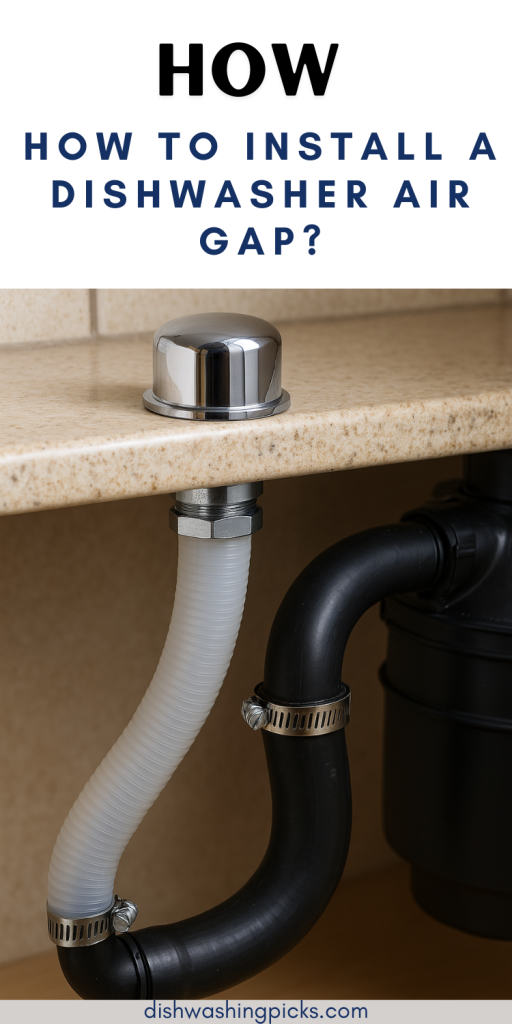
so you’re installing a dishwasher air gap. Maybe you just got a new dishwasher, or maybe your sink setup is giving off weird “Hey, I might flood your kitchen” vibes. Either way, you’ve found yourself in the wild world of plumbing, staring at a little metal or plastic thing that apparently keeps dirty water from sneaking back into your dishwasher.
Don’t worry—I got you. This isn’t rocket science (or even IKEA furniture levels of frustration). By the end of this, you’ll have that air gap installed and feel like a DIY pro. Let’s get into it.
What Even Is a Dishwasher Air Gap?
If you’re wondering, “Wait, do I even need this thing?”—good question. A dishwasher air gap is basically a small device that sits on top of your sink and acts as a one-way valve. It makes sure that dirty sink water never backflows into your dishwasher. Gross, right? That’s why building codes in a lot of places require it.
Think of it like a bouncer at a club. Your dishwasher is inside, chilling. Dirty water tries to crash the party? Nope, denied at the door. The air gap forces the water to take the right exit—down the drain, not back into your clean dishes.
So yeah, if your local plumbing code says you need one (which it probably does), or if you’re dealing with dishwasher drainage issues, you’ll want to install this little guy.
What You’ll Need (A.K.A. The Stuff You Should Grab Before You Start)
Alright, before we dive in, grab these tools and parts:
✅ Dishwasher air gap (obviously)
✅ Hose clamps (to keep everything secure)
✅ A small hose (⅝-inch or 7/8-inch, depending on your setup)
✅ Another hose (typically 7/8-inch) to connect to the garbage disposal or drain)
✅ A wrench or pliers (because you’re gonna be tightening stuff)
✅ A screwdriver (for clamps and other random stuff)
Got everything? Cool. Let’s move on.
Step 1: Find the Right Spot for the Air Gap
Most kitchen sinks already have a little hole next to the faucet for a sprayer or soap dispenser. If you’re lucky, you can pop that out and use the hole for your air gap. If not, you might need to drill a hole in your countertop. (But let’s be real, if you’re drilling holes in countertops, maybe call in backup.)
Once you’ve got a hole, slide the air gap into place, with the wider end on top. Secure it with the locking nut underneath the sink. Hand-tighten it first, then give it a little extra twist with a wrench. Not too tight—you don’t want to crack anything.
Step 2: Connect the Hoses
Alright, here’s where things start looking like a spaghetti mess of hoses, but don’t stress. You’ll be connecting two main hoses:
🔹 The first hose (small one) goes from the dishwasher to the air gap. Attach one end to the dishwasher’s drain outlet and the other to the smaller nozzle on the air gap. Use hose clamps to secure both ends.
🔹 The second hose (bigger one) goes from the air gap to the garbage disposal (or sink drain). Connect one end to the larger nozzle on the air gap and the other to the garbage disposal’s inlet (or the sink drain if you don’t have a disposal). Again, tighten those hose clamps.
A quick test: Tug on the hoses gently. If they pop off, they weren’t tight enough—go back and clamp them down properly.
Step 3: Test It Out (Moment of Truth)
Now, the fun part—turn on your dishwasher and let’s see if everything holds up. Watch the air gap as the dishwasher drains. If water spurts out the top like a mini fountain, something’s clogged. Check for blockages in the hose leading to the disposal or drain.
If everything’s running smoothly and water is going where it’s supposed to—congrats! You just installed a dishwasher air gap like a total pro.
See? That wasn’t so bad. Now your dishwasher is safe from nasty backflow, and you can officially say you’ve done some legit plumbing work. Look at you, being all handy and stuff.
If you run into any issues, check your hoses for kinks or clogs. And if something’s still not right, don’t be afraid to call in a pro—because let’s be honest, there’s only so much DIY before things start getting really frustrating.
Now go run your dishwasher and enjoy your fresh, clean dishes—without worrying about sink gunk sneaking back in. 🚰💪
